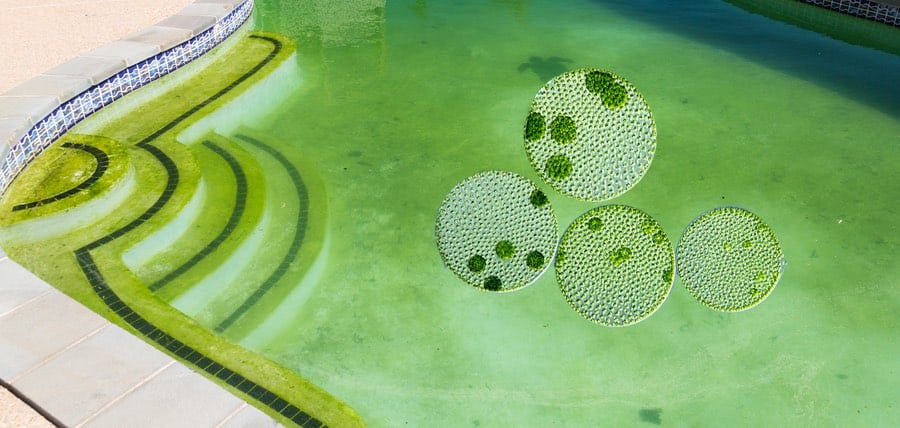Green Algae in Swimming Pools
It is a beautiful summer day. The air is warm, the sun is bright, and your pool is … green. No one wants a green pool. Usually, the causes of green pool water are algae, pollen or not enough chlorine in your pool. In this post, we will talk specifically about green algae in swimming pools and how to get rid of green algae in a pool.
What Causes Algae in Pools?
Green algae are present naturally in the environment. The spores are carried through the air and float around until they find a resting place where they can settle and begin to grow. Algae can also be carried into your pool by someone’s bathing suit or by pool equipment. If your pool water is properly cleaned and filtered, the algae will be taken care of without much trouble and before it gets a chance to spread. An algae bloom can happen really quickly because algae are always available in pools at a microscopic level. It only takes a few hours for algae blooms to get started, especially if the pool gets low on chlorine levels, or the pump or filter are not running properly. A rising pH level can also indicate a problem with algae.
How to Get Rid of Green Algae in Swimming Pools
If you have green algae in your swimming pool, there are several methods you can try to get rid of the problem. If your pool water is green and you can see visible clumps of algae floating in the pool, you will need to try chlorine cleaning first because your pool didn’t have enough chlorine to kill the algae on a daily basis. Chlorine might also be used at the beginning of the season. Using a large dose of chlorine is called “shocking,” and it will return your pool to a more sanitary state. Shocking the pool usually takes from one to three days. But, be prepared, it may take as long as a week if your pool was in poor sanitary condition. Before you use the chlorine, however, make sure you vacuum or sweep up all the algae on the bottom of the pool, as well as the off the pool walls and around the ladders.
While chlorine works for getting rid of swimming pool algae, there are other methods as well. The others listed below are faster than chlorine for removing algae. But, if you have an underlying sanitation issue, these methods won’t be able to fix it. While chlorine is hazardous and needs to be used with the proper safety precautions, the alternative methods are more expensive and have side effects that chlorine doesn’t have.
One way to get rid of green algae is a flocculant. This clumps the algae together and makes them easier to vacuum up. While this is an easier way than shocking the pool and waiting a few days, cleaning off the algae doesn’t mean the pool is safe. You will need to make sure your pool’s pH and chlorine levels are good before you can swim in the pool, which may mean you will have to shock the pool anyway.
If you have a particularly large algae bloom, you may want to think about an algaecide, which will kill all the algae. However, the cheap algaecides don’t work well, and the expensive ones may stain your pool finish because they contain copper. And, as with the flocculant, you will need to make sure the pool’s pH and chlorine levels are adequate.
With a little work and preventative cleaning, you will have a clean and algae-free pool to enjoy all summer.
We hope you have gained valuable knowledge regarding green algae in swimming pools. If you would like more information regarding new pool construction, outdoor kitchens, water features, fire features and or patio covers please feel free to contact Pulliam Pool Houston. We are located in Katy, TX and provide pool services throughout the Houston TX area.


Recent Comments